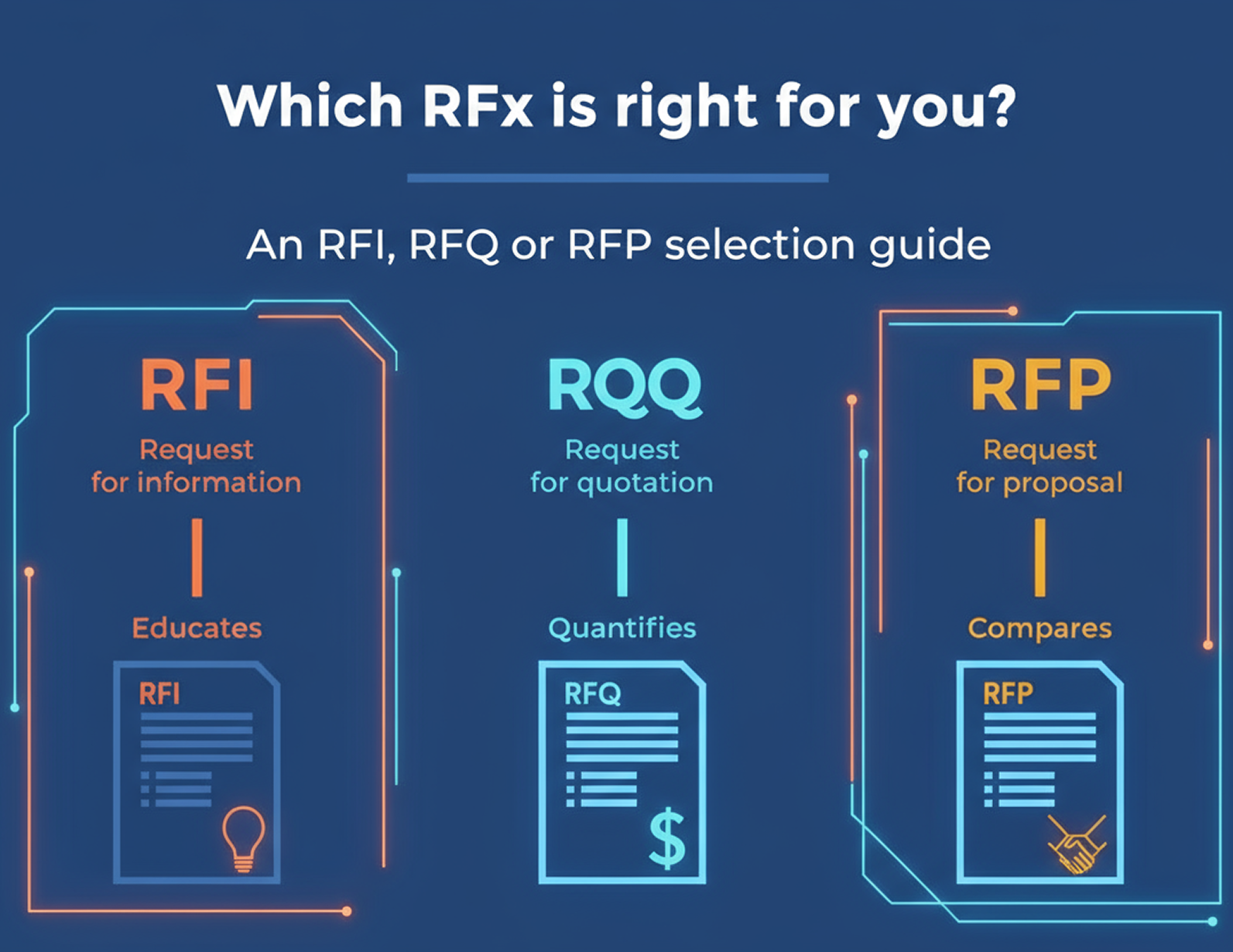In an increasingly competitive market, the ability to manage RFPs efficiently has become essential. By combining process streamlining with adaptation to buyers’ specific needs, these tools deliver a better user experience and optimize teamwork.
Adopting dedicated software allows companies to streamline their workflow, shorten turnaround times, and ensure transparent and collaborative management. More than a simple tool, it is a strategic solution to respond quickly and effectively to AI driven RFP questionnaires and calls for tenders.
For a comparison of leading tools, see Tenderbolt’s guide to top AI RFP software:
What is RFP AI and How It Works
RFP AI refers to the set of artificial intelligence capabilities that automate how organizations read RFP packages, extract requirements, and generate structured responses for proposals and questionnaires. In practice, the platform ingests the RFP and its annexes (including vendor portals), identifies mandatory items, dates, and evaluation criteria, maps each question to approved internal resources, and then produces a reviewer-ready draft.
The aim isn’t to replace human expertise, but to shift the workload: the system prepares roughly 70–90% of the content so your team can focus on relevance, differentiation, and substantive compliance. This machine-first drafting approach shortens cycles, standardizes terminology, and dramatically reduces omissions or inconsistencies across sections.

How AI Generates Accurate Answers from Company Knowledge
High-quality output starts with a high-quality knowledge corpus. Modern platforms ingest many formats (PDF, DOCX, spreadsheets, knowledge bases, past proposals, security policies, product docs) into a permissioned, centralized library. A semantic retrieval engine (embeddings) locates the best supporting passages even when a question uses different wording from the source material. Those excerpts are then supplied to the generative model, which drafts contextualized answers while maintaining traceability back to the original documents.
Two mechanisms strengthen reliability:
- Source attribution: Every answer can carry citations (document → section → paragraph) to speed review and support audits.
- Confidence scoring: The platform weights the “strength” of an answer based on content freshness, source authority, and semantic proximity.
For complex security questionnaires referencing multiple standards and frameworks, the AI can stitch together a coherent response from numerous attachments and references, consolidating evidence and control mappings without losing the level of detail that evaluators expect.
Technology Behind Generative AI for Proposal Writing
Several technical building blocks work together:
- Natural Language Processing (NLP): Classifies requirements, detects dates and formatting constraints, flags mandatory vs. optional elements, and maps questions to evaluation criteria.
- Vector-based retrieval: Goes beyond keywords to retrieve conceptually similar content (synonyms, paraphrases, domain phrasing).
- Large Language Models (LLMs): Generate text, rewrite in different registers (technical, executive, marketing), compress or expand content, and enforce editorial guidelines.
- Orchestration: Prompt templates, structured output constraints (tables, bullets, character limits), automatic citation injection, format validation, and human-in-the-loop approval loops.
The result is an end-to-end pipeline that turns heterogeneous resources into structured, cited responses ready for validation, with complete change history and auditability.
Traditional vs. AI-Powered RFP Processes
Traditional proposals rely on copy-paste from spreadsheets, expert email chains, manual trackers, and exhaustive document reading. An AI-powered approach starts with automated analysis: extracting themes, requirements, risks, gaps, and dependencies, then assembling a complete first draft. Exceptions and sensitive topics are routed to the right stakeholders (security, legal, product). Repetitive tasks are replaced by targeted review, compressing timelines and reducing coordination overhead. The cumulative effect: more submissions, better tailoring, and greater consistency across responses.
The Need for Automation in RFP Responses
Rising Volume of RFPs
In an increasingly competitive business environment, companies face a rising volume of RFP requests. This increase puts significant pressure on teams dedicated to RFP management.
Without automation, it becomes difficult to handle this growing workload while maintaining high proposal quality. Adopting automation technologies addresses this challenge by enabling more submitted responses and maximizing commercial opportunities, without a proportional increase in headcount.
Labor Intensive Processes
Traditional RFP response management still relies heavily on manual processes that demand substantial time and resources. Repetitive tasks such as information gathering, drafting, validation, and follow up often mobilize dispersed teams and slow down the workflow. Automation with an RFP software streamlines these complex processes.
This optimization reduces manual effort, lowers the frequency of errors, and helps teams focus their skills on higher value activities.
Error Reduction
The inherent complexity of the RFP process amplifies the risk of errors in proposals, including missing data, contradictions, or outdated information. By automating management with the right tools, you ensure effective content centralization, which guarantees complete, consistent, and compliant responses that meet client requirements.
With these technologies, you reduce human error and improve the overall quality of proposals, which strengthens your chances of winning more deals.
.webp)
Key Components of Effective RFP Response Automation
Integration with Existing Systems
To maximize the effectiveness of your RFP software, it must integrate smoothly with your existing systems such as CRMs, document management platforms, and collaboration tools. This smooth integration enables continuous information flow and limits data duplication across proposal management.
Quick access to client data and historical information is a strategic lever for tailoring your responses consistently and relevantly throughout the RFP process.
Template and Content Management
A cornerstone of a strong automation system is a centralized library for content and templates. With this capability, you can store, organize, and easily reuse standard answers, templates, and approved documents. That accelerates proposal production and ensures coherence and compliance.
A good automation solution also keeps content up to date, which avoids errors related to obsolete information. It also facilitates personalization for each specific call for tenders, which is a key advantage in a competitive environment.
Collaboration Features
Managing tenders often involves multiple cross functional teams working on different aspects of the project. An effective automation tool should offer advanced collaboration features that allow teams to work simultaneously, track progress in real time, and manage exchanges in an integrated way.
These features ensure optimal coordination, minimize the risks of errors or duplicates, and significantly improve the final quality of responses through a harmonized collective effort.
Assessing the ROI of RFP Response Automation
Time Savings
One of the main benefits of automating RFP responses is the significant time saving it delivers. By reducing repetitive tasks, this approach can cut RFP response time by 60% to 90%, depending on the solutions used.
This gives companies the opportunity to handle more requests in less time, which is essential in competitive markets where speed is a key success factor. With these tools, teams can devote more time to high value tasks such as crafting winning strategies and tailoring proposals to specific client expectations.
Win Rate Improvement
Automation can also improve proposal win rates in a meaningful way. By leveraging data and identifying key success factors in previous responses, companies can craft more relevant and persuasive proposals. For example, advanced tools like RFxAI can increase the win rate by up to 80% while drastically reducing the time needed to respond.
This technology also ensures greater consistency and compliance across responses, which are fundamental elements for maximizing success in any RFP process.
Long Term Strategic Benefits
Over the long term, integrating automation into RFP response management brings major strategic advantages. By centralizing resources and automating workflows, companies can establish a more structured and efficient approach to RFP management.
This contributes to process standardization, error reduction, and consistently high response quality. Such an approach strengthens the company’s credibility and improves its reputation in the market. Automation also supports continuous improvement through precise analytics that help evaluate past performance and refine future strategies.
Conclusion
Automating RFP responses is no longer optional, it’s a strategic lever for growth. AI-driven workflows turn days of drafting into minutes, enforce consistency across sections, and let your experts focus on win themes, compliance, and differentiation. The result is faster cycle times, higher quality submissions, and clearer visibility into KPIs that prove ROI.
If you want a practical path to those outcomes, Tenderbolt brings it together in one platform: retrieval-grounded generation from your approved knowledge, CRM and document integrations, browser support for vendor portals, and audit-ready reviews and approvals. Teams get value in weeks not months while tracking impact end-to-end (time to first draft, throughput, win-rate lift, and overall ROI).
Start with a live RFP or security questionnaire: let Tenderbolt produce the first draft, have your SMEs refine, and submit sooner with greater confidence.
Book a demo to see how Tenderbolt modernizes your RFP workflow and ROI.
FAQ: RFP Response Automation Software
1. What is RFP response automation software?
RFP response automation software is an intelligent, cloud-based management system designed to streamline and centralize how vendors respond to requests for proposals (RFPs). It helps teams simplify business processes, collaborate more efficiently, reduce manual effort, and accelerate proposal creation with fewer errors. These scalable management software solutions often include intuitive dashboards to monitor progress and automate recurring business-processes.
2. Why automate the RFP response process?
Automation saves time, reduces human error, and enables teams to respond to more RFPs without increasing headcount. It also improves the overall quality of proposals and increases your chances of winning new business. By using intelligent process automation, companies can simplify workflows, enhance transparency, and optimize business process management end-to-end.
3. What are the main benefits of using RFP automation software?
- Significant time savings (up to 90%)
- Higher win rates
- Fewer errors and outdated content
- Better cross-team collaboration
- Centralized content and template management
- Real-time insights via dashboards and case-studies showcasing improved business process automation
- Seamless marketing automation and vendor coordination within a single management software
4. Who should use RFP automation tools?
Any company that regularly responds to RFPs can benefit — especially those in B2B, tech, professional services, and healthcare. It’s particularly valuable for teams dealing with complex sales cycles, multiple vendors, or large volumes of RFPs. Organizations seeking scalable, cloud-based solutions for business-process automation will find these tools particularly effective.
5. Can the software integrate with existing systems?
Yes. Most modern solutions integrate seamlessly with CRMs (like Salesforce), document management platforms, and collaboration tools (such as Slack or Microsoft Teams) to ensure smooth workflows and avoid data silos. This integration across business processes helps create a unified dashboard experience, supporting both marketing automation and vendor management in a single, connected ecosystem.
6. Can responses still be personalized with automation?
Absolutely. While automation speeds things up, it also allows for tailored responses by leveraging up-to-date content libraries and customizable templates adapted to each RFP’s specific context. The intelligent orchestration layer ensures that every response reflects your brand’s tone, complies with requirements, and aligns with your internal business-process management standards.
7. Does automation really improve win rates?
Yes. Tools like RFxAI have shown the potential to boost win rates by up to 80%, using AI to analyze past performance and generate more relevant, compelling responses. The intuitive dashboard and built-in process automation features help teams continuously improve based on historical case-studies and analytics.
8. What are the long-term benefits of automation?
Over time, automation leads to more consistent processes, fewer errors, and higher-quality proposals. It strengthens your company's credibility and supports continuous improvement through analytics and performance insights. Implementing business process automation also ensures your management system remains adaptive, scalable, and future-ready as your vendor network grows.
9. How long does it take to implement an RFP automation solution?
Implementation timelines vary, but most cloud-based management software can be set up in a few weeks. Many companies begin seeing ROI within the first few months, especially when handling multiple RFPs or marketing automation processes in parallel. Built-in dashboards provide visibility from day one, helping teams monitor efficiency and track adoption rates.
10. Is it a good investment?
Definitely. By saving time, increasing response volume, improving proposal quality, and raising win rates, RFP automation software delivers a strong return on investment. The combination of intelligent, scalable, and cloud-based business process automation with intuitive dashboards allows businesses to grow sustainably while maintaining full control over their workflows and vendor relationships.
